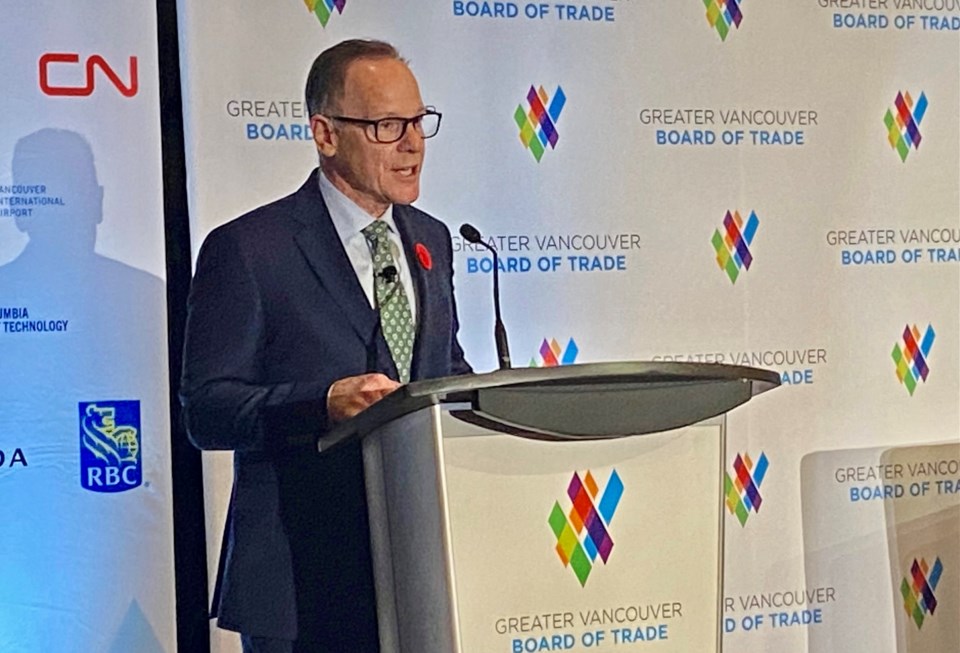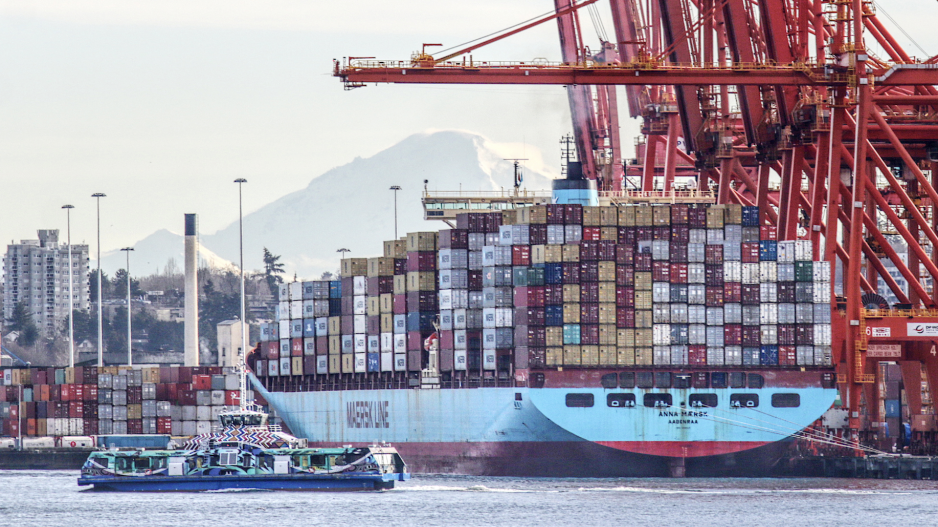From the time 91原创 Fraser Port Authority CEO Peter Xotta began speaking to the Greater 91原创 Board of Trade (GVBOT) Thursday at 12:30 p.m., to the time his talk ended about 30 minutes later, the cost of the present port shutdown went from $2.277 billion to $2.286 billion, according to the GVBOT’s port shutdown calculator.
Since the lockout unionized dock foremen began Nov. 4 at 4:30 p.m., the shutdown had disrupted more than $2 billion worth of goods.
The GVBOT launched its to underscore just how important the port is to Canada’s economy, and the impact the current shutdown is ramping up.
The Port of 91原创 is Canada's largest and busiest. It facilitates the movement of $300 billion in goods each year, directly employs 52,700 people, indirectly accounts for 132,000 jobs, and contributes to $32.7 billion in economic output and $16.3 billion in GDP.
Xotta spoke about the challenges and opportunities facing the port and global trade in general.
“We’ve got a few challenges that we need to overcome," he said, pointing to labour and other disruptions that have hit North American ports recently, as well as a crisis in the Red Sea.
Diversions around the Cape of Good Hope to avoid being fired upon by Houthi jihadists in the Red Sea has doubled the distance cargo, container and tanker ships have to travel now to deliver goods. All of this adds to costs, and supply chain slowdowns.
The most recent labour dispute to shut down 91原创's port is between the International Longshore and Warehouse Union Ship and Dock Foremen Local 514 (ILWU 514) and the BC Maritime Employers Association (BCMEA). After the ILWU 514 issued a job action notice, the BCMEA responded with a lockout on Monday.
It follows a strike by International Longshore and Warehouse Union Canada that shut the port down for 13 days, resulting in billions in costs to 91原创 businesses.
B.C. is not the only port to be hit with labour strife. Last month’s dockworker strike in the U.S. shut down Eastern U.S. ports for three days.
“That disruption alone was estimated to sideline two to three per cent of the global supply chain capacity,” Xotta said. “It really draws an asterisk beside the fact that disruptions in supply chain have long lasting effects on the supply chain cost of moving goods, and of course the reputation of those trying to move their goods.”
“Locally we continue to very and unpredictable gateway disruptions.”
Up until the recent shutdown, the port was having a pretty good year.
“Despite all the challenges, we’re doing well,” Xotta said.

Cruise ship business was brisk this year, and since May there has been a significant increase in oil exports, thanks to the newly expanded Trans Mountain pipeline and Westridge Marine Terminal.
The port expected to end the year with 327 cruise ship visits and 1.32 million passengers between March and October – a seven per cent increase over last year – and since May there have been more than 100 oil tankers shipments.
As for cargo volumes, recent optimization at the Annacis Auto Terminal resulted in what the port says is a record volume of 250,000 vehicles.
The port also marked record volumes for bulk liquids, thanks largely to the expansion at Westridge terminal.
Xotta credited the improved metrics for the port to investments made in recent years to transportation and gateway infrastructure.
"By our count, more than $9 billion has been invested in gateway and regional transportation corridors over the last 15 years by the private and public sector," Xotta said. "That includes port terminal projects, road and rail projects as well as the significant bridge projects that are supporting commercial truck traffic.
"Simply put, build confidence in the supply chain, investment happens."
Xotta cited "game-changing projects" driving the port's growth, like the Trans Mountain pipeline and Westridge Marine Terminal expansion.
"Far and away, the major story for 2024 is the Trans Mountain expansion project," Xotta said. "This is a $34 billion investment in Canada's transportation infrastructure that will drive the single biggest step function increase in trade volume that we've ever experienced in the Port of 91原创."
A major terminal project is the Westshore Terminals coal terminal expansion -- an investment of nearly $1 billion that will allow the coal shipping terminal to diversify into potash.
The next big terminal project will be the long-delayed $3.5 billion Roberts Bank Terminal 2 container terminal project, which received federal and provincial approvals last year.
"It's a generational prosperity building project," Xotta said.
The next terminal project that may be considered for 91原创 is a second cruise ship terminal. The current berth cannot accommodate some of the larger new cruise ships, which means 91原创 may be missing out on opportunities to expand this critical component of tourism.
The port had explored a possible second terminal that Xotta said "turned out to be not as viable as we might have hoped."
"It is an increasing challenge for us in terms of sustaining our market position, and we've got to address this because 91原创's clearly the preferred launch point, using YVR and coming to this city versus the other locations," Xotta said. "It's becoming a critical issue."
The Port of 91原创 facilitates the movements of $300 billion in goods each year, directly employs 52,700 people, indirectly accounts for 132,000 jobs, and contributes to $32.7 billion in economic output and $16.3 billion in GDP.




